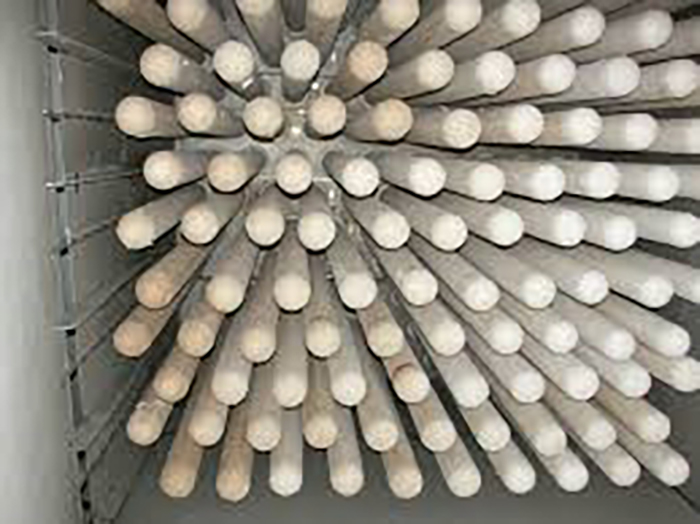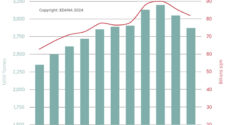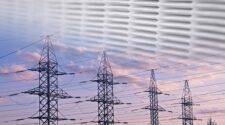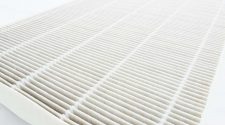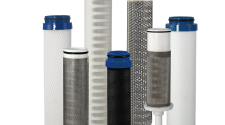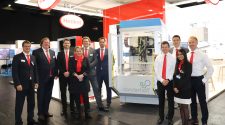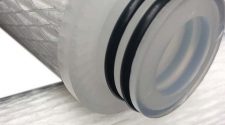The true cost of a filter depends on external factors such as urgency and environmental impacts. The Russian invasion of Ukraine has greatly increased the urgency of acquiring filters in certain applications. It has also introduced a freedom factor which temporarily supersedes climate change priorities.
The invasion and tacit support by China have created greater urgency in developing semiconductor capacity in Europe and the U.S. Taiwan supplies most of the world’s advanced chips. It is now perceived to be much more vulnerable than it did before the invasion. There was already double-digit expansion of the world’s semiconductor industry. The invasion will accelerate investment in new chip plants and the filters which are vital to chip production.
Filters are required to purify the wash water and the etching chemicals. A category in short supply are the HEPA filters needed for the cleanrooms. There is already a shortage of HEPA filters due to the large demand for air purifiers needed in the COVID battle. A large chip plant can require 50,000 ft2 of filters requiring over 2 million ft2 of media.
Filtration and separation are critical in producing various fuels to replace Russian oil and gas. The free world is united in a program to eliminate Russian energy purchases. People are motivated in a way not seen since the OPEC oil embargo in 1973. At that time an alternative fuels program was immediately launched. In retrospect the technology choices were not optimum. A crash program is like a jury trial. Decisions have to be made within days. If the body of evidence is not comprehensive and well organized a poor decision can result.
In 2021, Russian crude and condensate output reached 10.5 million barrels per day (bpd), making up 14% of the world’s total supply. Russia has oil and gas production facilities throughout the country, but the bulk of its fields are concentrated in western and eastern Siberia. In 2021 Russia exported an estimated 4.7 million bpd of crude to countries around the world. China is the largest importer of Russian crude (1.6 million bpd), but Russia exports a significant volume to buyers in Europe (2.4 million bpd).
Russia is the world’s second-largest producer of natural gas, behind the United States, and has the world’s largest gas reserves. Russia is the world’s largest gas exporter. In 2021 the country produced 762 bcm of natural gas and exported approximately 210 bcm via pipeline.
If it had not been for the inventions around shale fracturing in the 1990s the failure of the U.S to develop an alternative fuels program would have resulted in $200/barrel oil today and a dominance of Russia and OPEC.
Russia has a wide-reaching gas export pipeline network, both via transit routes through Belarus and Ukraine, and via pipelines sending gas directly into Europe (including Nord Stream, Blue Stream, and TurkStream pipelines). Russia completed work on the Nord Stream II pipeline in 2021, but the German government decided not to approve certification in the wake of the Russian invasion of Ukraine. Russian natural gas accounted for 45% of imports and almost 40% of European Union gas demand in 2021.
It will be more difficult for Russia to sell its gas if Europe does not purchase it. Oil is more easily delivered around the world. However, oil sold to China or India at a discount will substantially reduce Russian revenues. Furthermore, the lack of international products including filters will make production less efficient.
Filtration and separation will play a major role in providing alternative fuels for Europe and other free countries.
This is the impact over 10 years of replacing Russian energy. Even though the primary activity will be in Europe, higher gas and oil prices around the world will also incentivize other countries to select alternative options. The largest potential is bioenergy with carbon sequestration. The 4000 MW Drax power plant in the UK is now burning wood pellets primarily imported from the U.S. It is completing a project to sequester CO2 in the North Sea. This is a carbon negative technology.
A 4000 MW BECCS plant reverses the CO2 contribution to the atmosphere. The significance is twofold.
- Even though a temporary alternative fuels program can add CO2 there is no tipping point. BECCS can bring down CO2 levels in the future.
- Any BECCS will offset carbon producing options. So, 4000 MW of conventional coal plant life extension plus 4000 MW of BECCS = 8000 MW of carbon neutral electricity.
- The U.S. faced a similar situation in 1973 when OPEC banned oil exports to a country supporting Israel. A number of technology choices were made without access to an organized evaluation system. Highest on the priory list were
- oil shale (not shale oil)
- new coal fired power plants
The plan was to make Colorado the oil capital of the world with a technology used for oil sands in Canada. Huge construction sites were built in a short time. Electric heat was to replace gas heat. 85,000 MW of new coal fired power plants were ordered by U.S. utilities. Six months later the oil embargo was lifted. No oil shale plants were built in Colorado. In the 50 years since the big coal plant orders less than 30,000 MW of new coal plants have been built. So, cancelations have exceeded new orders.
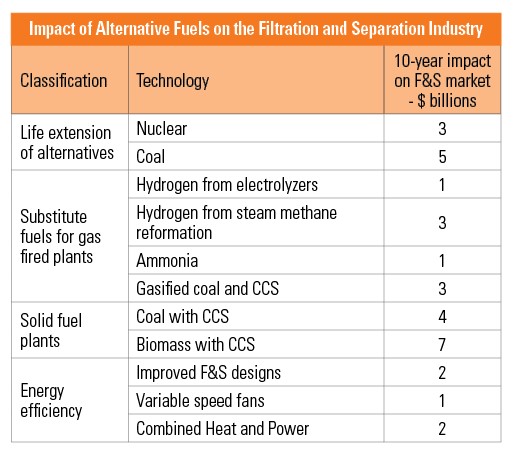
In similar crisis situations South Africa and Nazi Germany made a different choice. Germany opted for coal to liquids (CTL). During World War II most of the airplane and tank fuel was produced by CTL. South Africa during the apartheid era built the huge Sasol complex and made both fuels and chemicals. Today that technology is being extensively employed in the Chinese chemical industry.
The only relic of the 1973 program is the Great Plains plant in North Dakota. It has produced coal gas, ammonia, and hydrogen from coal. It has piped CO2 for enhanced oil recovery to Canada. The plant is being revamped to use shale gas to produce hydrogen and ammonia.
If it had not been for the inventions around shale fracturing in the 1990s the failure of the U.S to develop an alternative fuels program would have resulted in $200/barrel oil today and a dominance of Russia and OPEC. The free world cannot afford to make the same haphazard decisions made in 1973.
Filter suppliers can do their part to make sure better decisions are made. Their knowledge and products can make the difference in terms of achieving the goals within the cost and time frame needed.
The supplier effort can resemble a series of jury trials with the following coverage.
- Targets: Determine the opportunities. This is the equivalent of determining whether to litigate. Comprehensive market forecasts are needed to choose the Most Profitable Markets.
- Predicate evidence: In a trial or a sales campaign it is necessary to establish the relevant facts.
- Disputed Evidence: It is necessary to understand the competitor’s offering and what he will be telling the purchaser.
- Product Validation: The presentation to the purchaser has to address the arguments made by the competitor and show why the supplier’s product will have the lowest total cost of ownership. The purchaser, like a jury, will be hearing both sides.
Here is an example of the coverage.
BECCS is the largest potential for filtration and separation. RO systems are used for ultrapure water to produce steam. Filters purify cooling water. Scrubbers and fabric filters are needed for FGD, and other purposes within the plant. Scrubbers are needed for CO2 capture.
Predicate evidence includes the environmental impacts of a carbon negative solution. BECCS has been incorporated into most plans to achieve net zero carbon emissions. One of the attractions is that it can be progressive. Drax started by co firing biomass with coal. Then it converted to all biomass. Now it is moving toward the CO2 sequestration. A subject requiring both predicate and disputed evidence involves the dangers of CO2 levels in the atmosphere at various times in the future. Does BECCS eliminate a tipping point argument? How does BECCS compare to direct separation as the other carbon negative approach? The essence of all the arguments is
- quality of life impacts
- discounted future values
- tribal factors
The perspective of a Ukrainian father trying to ensure survival of his family is different than from a wealthy European setting up trusts for his grandchildren.
Disputed evidence includes the choice for particulate and acid gas removal from the biomass combustor. The typical approach would be to use three vessels for NOx, particulate and acid gas removal. Additional gas purification would take place in the CO2 recovery system.
It can be argued that the cost can be reduced by using ceramic filters with embedded catalyst. Direct sorbent injection ahead of the filter will eliminate the acid gases. So, three vessels are reduced to one. The capital cost reduction is substantial.
It will be argued that the one vessel approach is not as efficient as the three-vessel approach. But there is a downstream purification system needed in either case. So the dispute involves the total purification investment.
President Vladimir Putin has now changed his message to the Russian people. The campaign to incorporate Ukraine into the Russian empire is deemed essential. It may take 30 years, says Putin, but it has to be done. He is now being denounced as a war criminal. Under these circumstances it is likely that Russian energy will be embargoed for years to come.
The free world cannot afford to make poor decisions relative to alternate energy supplies. Filtration and separation suppliers can make the difference in providing alternative energy options in a cost effective and timely manner.
The Mcilvaine company is providing market forecasts for suppliers and true cost articles for IFN. This magazine has a convenient search engine which provides both predicate and disputed evidence to help validate the claims of the suppliers. IFN collaborated with FiltXPO to provide organized evidence around specific issues and involved speakers, exhibitors and attendees at the March convention in Miami.


